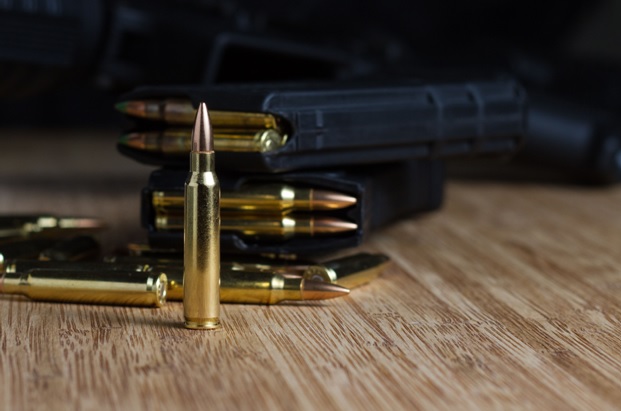First off, right out of the gate we need to get this out of the way. This article is not intended to suggest that one of these cartridges is better than the other. So don’t expect an absolute statement that either one or the other of these two cartridges is superior in any way.
Rather, this article intends to offer 4 specific reasons which, if they apply to you, would make a .300 Blackout upper a good choice for your next rifle build.
.300 Blackout vs. .223 Remington
The .300 Blackout and .223 Remington cartridges have shockingly similar cartridges. Basically, the .300 AAC Blackout came about because there was a need to shoot a .30 caliber bullet without a complete shift from the AR-15 to the AR-10 platform.
The parent case of the .300 Blackout is the .223 ( with some influence from the .221 Fireball), and in fact, the .300 Blackout case is basically identical to the .223, just trimmed and necked down.
This gives the .300 AAC Blackout the unique advantage that the same cases can be resized and trimmed to load either .300 or .223 rounds.
The .300 AAC Blackout also fires a larger, heavier bullet and produces slower muzzle velocities than the .223 Remington - which offers the following 4 reasons that a build with a .300 Blackout upper may indeed be for you.

1. You Expect to Use the Rifle for Short-Range Defensive Applications
While the .223 Remington can make an excellent defensive or sporting round in select applications, the .300 AAC Blackout is optimized for stopping power at close ranges (within 100 yards).
It has a drooping trajectory, with some subsonic loads dropping about 4” at 100 yards but as much as 2.5’ at 200 yards, but within 100 yards, this cartridge offers excellent stopping power.
A 115-grain .300 AAC Blackout bullet that exits a 16” barrel at 2,295 FPS will produce 1,344 ft-lbs of energy, and some loads can produce more than 1,400 ft-lbs of muzzle energy. Compare this to a common muzzle energy of about 1,280 ft-lbs for the .223 and you can see a bit of a difference.
The crux here is the lighter, smaller bullet of the .223 cartridge, which, though it shoots faster and flatter, is not as effective at providing optimal energy transfer and producing stopping power as the heavier .300 AAC Blackout bullet.
Loaded with a soft point or hollow point, the .300 Blackout offers some substantial advantages by comparison, especially at close and intermediate ranges.
And, since the only real difference between an AR chambered in .223 and one chambered in .300 BLK is the barrel, you can get more stopping power with the .300 BLK without changing any of the other handling characteristics of the rifle.
Truthfully, within 100 yards, the .300 Blackout has just about every advantage over the .223 with the exception of recoil which is still minimal.
2. You (Almost) Never Shoot at Long Ranges
This argument has already been implicitly made, given one of the observations covered in the last section. The .300 AAC Blackout has a badly drooping trajectory, whereas the .223 does not.
Your average .223 load will drop about 3.5” at 200 yards and 14.5” at 300 yards if zeroed at 100 yards. Compared to the .300, this is stellar performance, given the fact that .300 BLK drops so dramatically past 100 yards.
It’s hard to talk about averages here since you have to take into account bullet weight, barrel length, and whether or not the load is subsonic, so let’s look at a specific example.
Take a 150gr .300 BLK bullet that leaves a 16” barrel at 1,950 FPS. If zeroed at 100 yards, the bullet will drop about 9.7” at 200 yards and over 30” at 300 yards.
That’s pretty bad for long-range shooting, with nearly 3’ of drop just 200 yards beyond zero. But here’s the thing: if you never shoot that far, who cares?
We’ve already established that the main virtue of the .300 BLK is within 100 yards and in terms of stopping power. When you shoot at great ranges (unless you are a military sniper or a hunter) stopping power doesn’t really matter - just trajectory, wind drift, and general accuracy, both of which are partial products of ballistic coefficient.
So if you do a lot of long-range shooting, pass on the .300 AAC Blackout. If not, it might make a good option.
3. You Hunt Medium Sized Game at Close and Intermediate Ranges

All things considered, the .223 Remingont makes an excellent varmint cartridge. It is cheap, flat-shooting, produces low recoil, and offers excellent stopping power for varmints and predators like foxes and coyotes.
But if you hunt larger game, some more stopping power might be in order, especially if you routinely hunt at close ranges. Game such as hogs and deer, which are customarily pursued at closer ranges anyway, will yield more readily to a bullet that hits harder, like a .300 AAC Blackout.
And, this cartridge gives you the ability to take that step up with a barrel change, instead of making the longer step towards .308.
4. Recoil Doesn’t Bother You
Last but not least, we have to address recoil. Some shooters will naturally gravitate towards the .223 because it is one of the lightest-kicking centerfire cartridges out there.
That’s all well and good, but if recoil doesn’t matter to you, then a rifle with a .300 Blackout upper might be better because then you can reap the other benefits of superior close- and intermediate-range stopping power.
Getting Started with a .300 Blackout Upper
Getting ready to start your next build with a .300 Blackout upper? We carry a wide range of complete, assembled uppers as well as sundry parts, so if you need a .300 BLK compatible barrel, muzzle device, or bolt carrier group, we have what you need.
Take a look through our collections of AR parts and kits and get in touch with us at Sales@MCSGearup.com if you have any questions.

